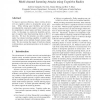Free Online Productivity Tools
i2Speak
i2Symbol
i2OCR
iTex2Img
iWeb2Print
iWeb2Shot
i2Type
iPdf2Split
iPdf2Merge
i2Bopomofo
i2Arabic
i2Style
i2Image
i2PDF
iLatex2Rtf
Sci2ools
ICCCN
2007
IEEE
2007
IEEE
Multi-channel Jamming Attacks using Cognitive Radios
To improve spectrum efficiency, future wireless devices will use cognitive radios to dynamically access spectrum. While offering great flexibility and softwarereconfigurability, unsecured cognitive radios can be easily manipulated to attack legacy and future wireless networks. In this paper, we explore the feasibility and impact of cognitive radio based jamming attacks on 802.11 networks. We show that attackers can utilize cognitive radios’ fast channel switching capability to amplify their jamming impact across multiple channels using a single radio. We also examine the impact of hardware channel switching delays and jamming duration on the impact of jamming.
| Added | 03 Jun 2010 |
| Updated | 03 Jun 2010 |
| Type | Conference |
| Year | 2007 |
| Where | ICCCN |
| Authors | Ashwin Sampath, Hui Dai, Haitao Zheng, Ben Y. Zhao |
Comments (0)

